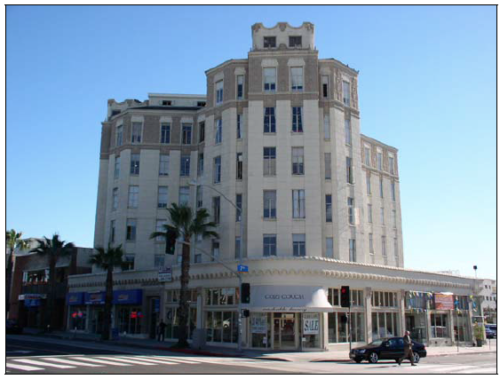Santa Monica Professional Building

- Known As
- Spanish Colonial Revival
- Architect
- Arthur E Harvey
- Built
- 1928
- Designated
- Aug. 8, 2005
Erected in 1928 of steel and concrete construction, the six-story Santa Monica Professional Building features an unusual plan embellished by the Plateresque variant of the Spanish Colonial Revival style. Features of this style include ornate low relief carvings highlighting arches, columns, window surrounds, cornices, and parapets. Features that also typify the style include stuccoed exterior walls; low-pitched, multi-level tile roofs; narrow casement windows; arched door openings; iron railings and window grilles; and corbeled balconies. The facades of large buildings often are enriched with curvilinear and decorated parapets, cornice window heads, and a symbolic bell tower.
The building was designed by Los Angeles-based architect Arthur E. Harvey (1884-1971) who was proficient in adapting period revival and Art Deco architectural styles to various building types in the years between the two World Wars. In addition to the subject property, some of the better-known extant buildings that Harvey designed include the French Norman style Chateau Elysee apartment/hotel (5930 Franklin Avenue, Hollywood, 1929), the Art Deco style American Storage Company tower (3639 Beverly Boulevard, Silver Lake, 1928-29), the Art Deco style Selig Retail Store (3rd Street at Western Avenue, MacArthur Park, 1931), and numerous one- and two-story period revival style apartment buildings and residences. In Santa Monica, Harvey was responsible for the Spanish Colonial Revival-inspired Embassy Apartment house (1001 3rd Street, 1927).
The overall plan of the 40,638 square foot building is “Y”-shaped with three tall wings radiating from the center of the first story base that is square in plan. Retail uses historically and currently occupy the ground floor while upper stories accommodate numerous professional offices.
In 1875, the original townsite of Santa Monica was surveyed, including all the land extending from Colorado Street on the south to Montana on the north, and from 26th Street on the east to the Pacific Ocean on the west. Between 1893 and the 1920s, the community operated as a tourist attraction, visited by mostly wealthy patrons.
Those areas just outside of the incorporated city limits were semi-rural in setting and were populated with scattered residences. After the advent of the automobile in the 1920s, Santa Monica experienced a significant building boom, with homes being constructed in the tracts north of Montana and east of Seventh Street for year-round residents. Commercial buildings, primarily one- or two-story in height, initially concentrated along 2nd and 3rd Streets between Colorado Avenue and Wilshire Boulevard also began to expand eastward at this time.
At the time of its construction the Santa Monica Professional Building heralded the development of the west end of Wilshire Boulevard as a major commercial corridor of multistory buildings. The April 7, 1929 edition of the Los Angeles Times noted, “Wilshire Boulevard, from downtown Los Angeles to the sea at Santa Monica, is ‘going up’ and one of the newest examples of modern business buildings at the Santa Monica end of the great artery is found in the $750,000 Santa Monica professional building.”
In 2019, the building was rehabilitated and adaptively reused as 55 rooms with ground floor commercial space as part of the new Proper Hotel. The five-story building was refurbished, including rehabilitated steel windows and storefronts, restored interior circulation spaces and significant seismic improvements. The historic building is linked to a much larger development on the remainder of the block. In a unique process with extensive public process and design review, the project team developed a compatible new structure with a compelling modern expression in harmony with the historic building. The project was awarded a 2020 Preservation Award by the Santa Monica Conservancy.
Sources:
- Santa Monica Mirror. “710 Wilshire Boulevard Development: What Say You?“
- City Landmark Assessment Report.